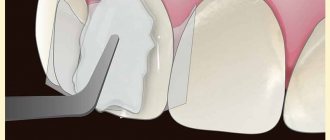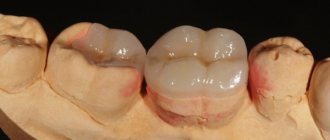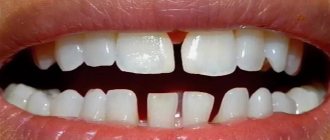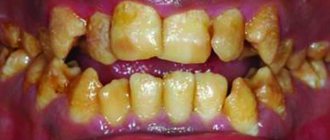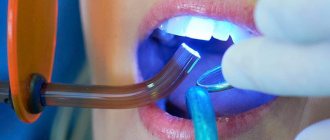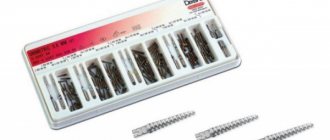Impress ceramic crowns are high-quality materials, made in Germany. The advantages are strength and aesthetics to excellent biocompatibility.
We all sooner or later face such a problem as excessive wear of a tooth or teeth due to severe caries or breakage. Sometimes a regular filling cannot save our teeth, since they are very badly damaged.
And this is where crowns come in to help us! As we know, crowns give us a greater advantage than fillings. Today we will tell you about Empress ceramic crowns. We will describe to you in general terms what it is. We will also talk about the advantages of Impress crowns. And of course, we will also talk in general terms about the process of making Empress crowns.
Empress veneers review: key features, scope, reviews and prices
Article navigation
- Features and benefits of veneers
- Classification of materials
- How is it different from normal
- What is the difference between Empress and E.max veneer?
- Indications for installation
- When not to bet
- Manufacturing and installation stages
- Life time
- Recommendations
- Alternatives
- What is the price
- Questions and answers
Question for a specialist
Veneers in general are designed to hide visible defects and create a perfectly smooth and dazzling smile. Despite the common shape and indications, products from different brands differ in a number of characteristics - some are stronger, some look completely indistinguishable from natural teeth, and some have a very attractive price. Among them are Empress veneers, which have become the “gold standard” in the field of dental prosthetics using leucite glass ceramics.
Features of glass-ceramic crowns “Empress”
The IPS Empress system is universal. With its use, crowns are created to eliminate both single and multiple defects, as well as core inlays and veneers. With the right approach, it allows you to restore speech and chewing functions, as well as restore your smile to its former beauty. Glass ceramics is a unique material intended for creating crowns that:
- very strong and durable;
- visually do not differ from natural teeth;
- do not absorb odors, do not change color;
- do not contain substances toxic to humans;
- do not irritate the gums;
- do not require maximum tooth preparation;
- provide a tight fit, thereby preventing the penetration of pathogens under the crown.
Features and benefits of Empress veneers
The word Empress (read as “Impress” or “Empress”) translated means “empress”. The brand of veneers received this name not by chance, but due to its high-quality characteristics - strength and aesthetics, which are maintained throughout the entire service life. The history of the Empress brand began about 20 years ago, when the famous company Ivoclar Vivadent (Liechtenstein) released its first glass ceramics. That is, Empress linings are not ceramic, but glass-ceramic.
Interesting! In general, glass ceramics were first produced in 1968 and they even began to be used for dental prosthetics. But all plans were crossed out by acrylic plastic, which at that time seemed to be the best solution in terms of quality and price (and ease of production). However, over time, its negative properties were discovered - abrasion and allergenicity, so manufacturers again returned to glass ceramics.
South Korean implant Osstem - from 35,000 rubles.
Hurry up to sign up for a free consultation and lock in promotional prices.
Call now or request a call
Opening hours: 24 hours a day - seven days a week
Empress veneers have several special qualities that are their advantages:
- unsurpassed aesthetics: the onlays cannot be distinguished from real teeth - they have a similar color, play of shades from the base to the cutting edge, translucency and shine,
- high strength and reliability ensures long wearing life,
- do not change color over time under the influence of dyes,
- thinness of the product: the thickness of the lining is about 0.3 mm,
- As a rule, they do not require grinding of teeth before installation, at least not much.
Expert opinion
Evgenia Vladimirovna Bolshakova
hygienist
Experience: 10 years
Some patients are afraid to get veneers because of the need to grind down the enamel and are looking for options without the need to prepare the top layer. But this point is extremely important, as it allows for maximum adhesion and tightness of the lining. In this case, plaque does not get clogged underneath it and the risk of developing caries in the tooth restored with the onlay is reduced. If for some reason the veneers have to be removed, the prepared front part will require prosthetic crowns.
Empress material classification
For the manufacture of overlays, as already noted, special leucite glass ceramics (IPS Empress) are used. The material goes through two stages of heat treatment, as a result of which technicians manage to create a strong crystal lattice. Its strength is explained by the fact that there are many crystals and they are large in size, arranged in an orderly and even manner.
In total, Ivoclar Vivadent, which has already produced 40 million veneers, produces 2 types of IPS Empress glass ceramics - IPS Empress Esthetic and IPS Empress CAD.
On a note! Ivoclar Vivadent also produces a paste-like stain for imparting precise shades to veneers - IPS Empress Universal Shades/Stains, and a ceramic for layering (or veneering) on glass-ceramic blanks - IPS Empress Esthetic Veneer. And for high-quality fixation of restorations, composite cements are offered - the highly aesthetic Variolink II, Variolink Veneer and the universal Multilink Automix. That is, everything you need to create a high-quality and aesthetic restoration.
Brand “E O” from the IPS Empress Esthetic group (for pressing)
Pressing technology for making veneers became a standard in the 90s of the twentieth century (blanks are pressed at elevated temperatures). According to the manufacturer, single crowns, restorative inlays for chewing teeth and veneers can be made from IPS Empress Esthetic. Moreover, for the latter, the IPS Empress Esthetic variety under the “E O” label is used.
A total of 7 different shades of this material are available, which are suitable for people with teeth of low transparency, or for those who have recently undergone whitening dental procedures. IPS Empress Esthetic materials are characterized by high flexural strength (160 MPa), natural refraction of light falling on the smile and excellent fit to the teeth.
Multi-blocks (Multi) IPS Empress CAD for milling
The milling process in prosthetics appeared relatively recently and differs significantly from pressing. Because it allows you to make restorations with greater precision - after all, the veneer is “cut out” using robotic equipment using CAD-CAM technology and eliminates possible errors (human factor). Although a dental technician is involved in modeling dentures using computer programs.
Read on the topic: what is a CAD/CAM system – and why more and more dentists are purchasing it.
IPS Empress CAD Multi blocks have a balanced chameleon effect, i.e. The color of the veneer changes smoothly along the length (it is darker near the gums, and lighter closer to the cutting edge). The restorations are translucent and very strong (160 MPa) in bending. The blocks are already painted in natural shades, so they do not require additional pigmentation. By the way, the manufacturer offers a choice of 16 shades A-D according to its own Chromascop scale, similar to the VITA scale popular among dentists.
If a patient needs only 1-2 veneers, then they can be made in literally half an hour right in the dentist’s office. If, of course, the orthopedist has the appropriate milling equipment - for example, the CEREC CAD-CAM complex.
Pressed products cannot be made quickly either - they are made only in the laboratory, and not in the office. But it’s fair to add that for office manufacturing using the milling method, the dentist must very accurately select the color of the workpiece so that it does not have to be painted (this is also already done in the laboratory).
Kinds
The following types of products are used for restoration:
- Multi: available in several versions, there is a gradient solution, ultra-light shades, used for veneers, restoration of teeth in any part of the row;
- HighTranslucency: Highly transparent, available in sixteen colours, with a natural chameleon effect for harmonious integration into the surrounding range;
- Medium Translucency: products with medium transparency, suitable for using reduction or coloring techniques;
- Low Translucency: available in a wide range of shades, usually used for the side group, characterized by color saturation;
- Medium Opacity: has a medium opacity, is produced in five shades, is used for the framework of discolored or vital teeth;
- High Opacity: designed for installation on titanium abutments, with pigmentation;
- Impulse: vary in brightness, there are two options - Impulse 1 and 2, the material is intended for ultra-thin veneers, where a light, natural opalescent effect is required.
What is the difference between Empress veneer and regular ceramic veneer?
Empress's properties are more reminiscent of thin lumineers than conventional veneers. “Impress” is distinguished from standard structures made from porcelain or ceramics1 by better aesthetics and greater strength – the classic ones have 50-75 MPa, i.e. 2-3 times lower. And also a reduced thickness, for comparison - classic linings have a thickness of 0.6-0.8 mm. Therefore, “Impress” requires less grinding of teeth. But due to the improvement of all characteristics, the price of treatment naturally increases.
Reviews
In recent years, different types of microprostheses have become popular. More and more dentists and their patients prefer inlays to fillings.
Perhaps you have your own experience in this matter. Please leave comments in reviews of the article.
If you find an error, please select a piece of text and press Ctrl+Enter.
Tags ceramic tab
Did you like the article? stay tuned
Previous article
Why does the crown on an implant wobble, and what can this lead to?
Next article
The Pros and Cons of Dental Implants with BOI
What is the difference between Empress and E.max veneer?
IPS Empress and IPS E.max are produced as one. The thickness of these pads is approximately the same - about 0.3 mm. And the difference between Empress and E max veneers is that “Empress” is made of leucite glass ceramics, and “E-max” is ceramics based on lithium disilicate, which has a higher strength of 470 MPa. That is, we can say that E.max linings are 3 times more resistant to loads and last longer, but they are also more expensive than Impress.
What are Empress crowns?
Firstly, it is worth saying that Empress crowns are manufactured by a German manufacturer. That is, the country of origin is Germany. German manufactured products have always been distinguished and are of excellent quality.
Empress crowns are undoubtedly a metal-free ceramic material. These crowns have become a very good new solution to metal-ceramic crowns. To increase the reliability and strength of Empress crowns, in addition to glass ceramics, leucite elements were added to them. Now we can talk about the advantages and features of Empress crowns.
Indications for installation of Empress veneers
- violation of the aesthetics of tooth enamel: cracks, discoloration, including those caused by smoking,
- minor damage to teeth: for example, chips, but not more than 30% of the total size of the crown,
- curvature of teeth: tilting, rotation around its axis, crowding - but only slightly pronounced,
- spaces and gaps between teeth (diastemas and trema),
- change in color of old fillings,
- increased sensitivity of teeth: reaction to cold/hot, sour/sweet,
- a person’s desire to make a smile more attractive: to lengthen or expand natural dental crowns.
“My aunt is a TV journalist, she got Empris veneers installed at a clinic in St. Petersburg about seven years ago. He still walks around with a very beautiful smile, all his teeth are white and even. It's even enviable, to be honest. But her mother jokes about her that now she has to live without shelling her favorite seeds. But what can you do, beauty is what it is, it requires sacrifice))).”
Zhenechka_99, review from the woman.ru forum
Examples of work “Before” and “After”
Gap between the front teeth - diastema
Case: Gap between the teeth and complaints about the aesthetics of the smile Work: 6 Empress Esthetic veneers on the front teeth and a metal-ceramic bridge on the lateral chewing teeth on the left Time: 6 days Number of visits: 3 Cost: 135,000 rub.
Restoration of anterior teeth with Empress veneers
Case: the patient complained of unsatisfactory aesthetics of the front teeth and a gap between the teeth.
Restoration of front teeth with ceramic veneers (May 2012)
Case: I went to the clinic with a complaint about the unsightly shape and position of the central incisors on the upper jaw.
Restoring aesthetics with lumineers
Case: the patient complained of unsatisfactory aesthetics of the anterior teeth (yellow enamel, curvature).
When you can’t install Impress veneers
- in case of serious malocclusion,
- if the teeth have massive fillings or chips of more than 30-50% of the top: only artificial crowns will help here,
- if there are small, but “old” fillings on the teeth: first they should be changed,
- with very thin tooth enamel,
- when practicing martial arts or hazardous sports,
- if there is caries and a large amount of plaque on the teeth: first you need to undergo dental treatment, as well as professional oral hygiene,
- if the patient is diagnosed with teeth grinding – bruxism.
Manufacturing technology
Within the framework of the technology under consideration, two methods of forming artificial crowns are officially allowed:
- The pressing method is a traditional option, in which a plaster model serves as the basis for the manufacture of prostheses. Processing the basis allows you to form a digital analog, which, in turn, sets the pressing settings. The finished system is subjected to thermal and mechanical stress, after which it is used in the procedure of implantation or restoration of the dentition;
- Three-dimensional milling is an automatic system, to start the cycle of which it is enough to scan the oral cavity. The computer program that controls the machine is responsible for processing the workpiece and the accuracy of the fit.
Pressed ceramics E-max is demanding in terms of processing, and forces clinics to purchase expensive equipment - however, the final quality of the finished prostheses fully compensates for all costs.
Manufacturing and installation stages
- grinding or slight grinding of the front surface of the teeth: so that the future veneer “sticks” well and the restoration does not appear larger than the neighboring teeth,
- taking an impression to make a model: the impression can be taken in the usual format - i.e. using impression material. Or they can use a special digital scanner - without which it is impossible to create a model for CAD/CAM technology,
- choosing the color of future restorations: since they can be “put on” only one tooth in a row, it is important to choose a color that will be identical to the shade of the remaining teeth,
- production of microprostheses by pressing or milling: the process takes from 1 to 14 days, depending on the amount of work and workload of the dental laboratory,
- installation of veneers - in just one visit to the dentist: onlays are glued with special dental glue (Variolink II, Variolink Veneer or Multilink Automix) to the front surface of the teeth, hiding visible imperfections.
What a smile looks like before and after installation of Empress glass ceramic veneers can be seen in the photo. Indeed, it is difficult to imagine that there was some kind of dental intervention here, because the teeth look very natural.
Prices for installing dental crowns
| Service | Price, ₽. |
| Consultation with an orthopedist | for free |
| Metal-ceramic crown Dutsera plus (Germany) | 9500 |
| Metal-ceramic crown Degussa M with shoulder mass (Germany) | 10500 |
| Ceramic crown Dutsera plus (Germany) | 20500 |
| Solid crown | 5500 |
| Ceramic crown made of zirconium dioxide | 35 000 25 000 |
| Empress crown | 19000 |
| Metal-ceramic crown on an implant | 19500 |
| Ceramic crown made of zirconium dioxide on an implant | 35000 |
| Temporary plastic crown/wedge. | 2300/1500 |
| Spraying the crown | 1500 |
| Taking an impression from alginate mass | 300 |
| Diagnostic plaster model | 300 |
| Taking a double impression | 800 |
| Stump inlay made of silver | 6800 |
| Stump inlay made of CoCr metal | 5000 |
| Stump inlay made of CoCr metal, dismountable | 5800 |
| Stump tab with micro-lock | 7500 |
| Ceramic stump inlay | 19000 |
| Zirconium oxide core inlay | 19000 |
| Cementing inlays and crowns using Fuji cement | 700 |
| Cementing inlays and crowns using Fuji+ cement | 800 |
| Temporary cementation of one crown | 400 |
| Removing one crown with stamped sawing | 500 |
| Removing one crown with sawing the cast | 1000 |
| Removing one crown with sawing MK | 800 |
Useful tips for wearing and care
Caring for Impress onlays is simple - just brush your teeth and have regular checkups with your dentist. But in everyday life, you should stop biting off foods with your front teeth - you must first cut them into small pieces, and forget about such habits that are harmful to your teeth, such as biting the tip of a pencil or biting off a thread. All this can lead to chipping of the veneer and significantly reduce its service life, despite the fact that the manufacturer guarantees the safety of the Impress structure for at least 10 years.
Dentists do not recommend using dental floss or ultrasonic toothbrushes, since the glass-ceramic lining may come off partially or completely. You should also not chew nuts, seeds or candy.
Care
Modern materials have extended the life of veneers by decades. But for this you need to properly care for them:
- Daily hygiene. Brushing your teeth at least 2 times a day. Rinse after eating. Using dental floss.
- The veneer itself may be strong, but its connection to the tooth will be disrupted if simple measures are not followed. precautions. Avoid cracking seeds and gnawing nuts. Avoid biting fruits such as apples and vegetables such as carrots.
- When engaging in contact or extreme sports, it is recommended to wear a protective mouthguard.
What alternatives can you name?
As an adequate alternative to Empress veneers, we can name E.max CAD Monolithic Solutions made from lithium disilicate, as well as the latest zirconium dioxide E.max ZirCAD Prime from the same manufacturer (but made using the unique GT gradient technology). If we consider other brands, then Prettau with the markings “1”, “2”, “3”, “4” may be an excellent option.
Don't know what type of prosthetics to choose?
We will help in the selection, advise where to read more information and compare types of prosthetics.
Consultation with an orthopedic doctor in Moscow clinics is free! Call now or request a call
Working hours: from 9:00 to 21:00 - seven days a week
When a patient wants a truly ideal and most durable solution, then the best choice is the installation of lumineers. But it is worth knowing that lumineers are manufactured only in the USA, and unique materials and technologies are used for this, so their cost is higher than all others.
Prices
Free online consultation with a dentist
| Service | Price |
| Installation of ceramic veneer E-max | from 28,000 rub. from 37,000 rub. promotion |
| Installation of ultra-thin ceramic veneer E-max | from 55,000 rub. |
| Installation of ultra-thin ceramic veneer SHOFU (Japan) | from 60,000 rub. |
Consultation and diagnostics are free!
All prices Promotions
Questions and answers on the topic
QUESTION: I read about Impress veneers and it’s not very clear how they differ from ceramic ones.
And their price is high. My dentist offered to make veneers for only 9 thousand. Andrey
ANSWER: Hello, Andrey. Empress veneers are not essentially ceramic, they are made of a different material - leucite glass ceramic, which is filled with especially strong crystals. The characteristics of the material and methods of its processing increase the cost of Impress veneers. Conventional ceramic ones are less durable and therefore can withstand loads less well. And pressed or milled glass ceramics will last without complaints for at least 10-15 years. As for veneers for 9 thousand rubles, most likely you were offered so-called therapeutic veneers. These are not onlays for teeth, but a layer-by-layer build-up of a composite composition on the tooth. Such solutions are relatively cheap and initially aesthetic, but the restored tooth will quickly lose its shine and color, and, of course, will not be as durable as if even a classic ceramic veneer had been installed.
- Gurel G., Ceramic veneers. Art and Science, 2007.
Author: Chorny S.V. (Thank you for your help in writing the article and the information provided)
Contraindications
The procedure for installing Empress veneers, like other types of microprosthetics, has a number of contraindications:
- malocclusion;
- the presence of large fillings on the teeth;
- tooth decay from the inside;
- predisposition to tooth wear;
- bruxism (teeth grinding);
- activities associated with the risk of dental injury (a number of sports games).
When to install
Restorations allow you to obtain the desired color of teeth and restore lost shape.
They also protect teeth by giving them strength.
Veneers are placed on teeth in the following cases:
Photo: Presence of stains on the front teeth
- When the front teeth are destroyed.
- If your front teeth have changed color.
- If there are cracks or chips in the teeth.
- If there are gaps between the teeth.
- When teeth are deformed as a result of changes in shape.
- Severe abrasion of teeth.
- In case of malocclusion and changes in the position of teeth.
- The presence of old fillings that have changed color and are noticeable against the background of the tooth enamel.
- For dental fluorosis.
- Presence of tetracycline teeth.
- After dental injuries.
